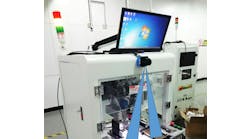Many applications require measurements in places where wires or the sensing devices themselves are difficult to place. And, if communication wiring isn’t viable, then power cables aren’t any more likely. But measurement data waits for no one. Our panel of industry veterans offers insights on going wireless and powering those devices.
Meet the panel
Kenneth Cunefare, Ph.D., is professor of mechanical engineering, Georgia Institute of Technology in Atlanta.
Tim Hazelton is product manager—wireless products, Banner Engineering.
Marshall Miles is managing director at Global Controls, a system integrator in St. Charles, Illinois.
Luis Torralva is North American marketing manager, Telemecanique Sensors.
Danny Weiss is senior product manager at Newark element 14.
What sorts of machine applications are wireless sensors best equipped to handle?
Cunefare: Wireless sensors are best used in inaccessible locations and locations where it is impractical or costly to run wiring. Inaccessible locations include on rotating or moving components of systems, such as directly on crankshafts or plungers. Other example locations include below the rotary joint on mobile equipment or beyond articulating joints.
Torralva: Wireless sensors or switches are the solution when cabling is difficult, expensive, or unwanted. It’s also the perfect way to give mobile machines more freedom of movement.
Miles: Wireless sensors are equipped for turret, mandrel or spindle-mounted container such as cans or bottles, presence, AGV’s load/unload cell position detection and robot end effectors in special cases.
Hoffman: Monitoring is a vital part of increasing the efficiency, reliability, safety and automation of machines. There are many different variables that need monitored in machines such as vibration, force, pressure and temperature. Sensors can take measurements of these different values and send the data back to a host to be referenced as needed. Wireless communication is one method of transporting this type of information. This method is becoming popular because of how cost-effective it is. Wireless helps to eliminate the need to run as many wires, perform maintenance and prevent conventional downtime associated with broken wires. Many different wireless technologies are available now, ranging from more robust, long-distance technologies to short-distance, high-speed technologies.
For applications such as machine control, material handling and automated guided vehicles, technologies like WLAN that have high bandwidth capabilities are preferable as they allow for real-time communication between end device and host. When sensor data needs to be transmitted through various obstacles, noise or long distances, wireless devices that transmit on lower frequencies like 900 MHz will provide more reliability due to their lower attenuation over the air. Applications with these types of requirements are typically for monitoring applications or non-application critical control.
Also read: Hydraulic pressure energy harvesting for wireless sensing
Wireless is not always the right fit for all applications. The use case and risk for each application needs to be evaluated. The user needs to ask the question, just as if they were using a wire: What happens if the wireless link breaks for a period of time? Is the result acceptable? Using wireless sensors is becoming more and more a normal operation in industrial applications. It offers one alternative to the traditional wiring techniques at a fraction of the cost.
Weiss: Wireless pressure sensors have a broad range of applications from process control and manufacturing to fluid-level monitoring in storage tanks and reservoirs. Liquid reservoirs and storage tanks are found throughout the industrial environment. They can be located in machine shops that use liquid coolant for their high-precision fabrication centers and may also be found in the rugged and harsh atmosphere of the oil and gas processing facilities. Some may even be used in close proximity to drilling and hydraulic fracturing operations, housing slurries or casing mud. Even though their locations and applications may change, storage tanks and reservoirs are used by organizations that need to know the fluid level housed within them. Knowing when a tank is full, or nearly empty, could be the difference between running smoothly and costly downtime. When the tanks are in a remote area, it is not always cost-efficient running wiring or cabling.
Large process facilities often have storage tanks that were built with no fluid-level-indication systems. With Honeywell’s WPS Series wireless pressure sensor, retrofitting tanks requires minimal effort when compared to wired solutions. Some customers may have tanks located far from central control systems. Running wires and cables to these locations could be expensive. Since the WPS Series does not require wires, the customer may now be able to reach areas and tanks they have not been able to in the past through the use of Honeywell WPS Series pressure sensors.
When making paper pulps, the pressure of the bleaching chemical injected into the mixing basin can inform the customer that the chemical is dispersing with the correct volume and at the correct temperature. In the final stages of paper-pulp production, the pressure and temperature of material, in conjunction with the time elapsed, can ensure containers of paper pulp are filled to the correct level. Again, many of the tanks are in remote areas and many are within a harsh environment. Wireless sensors are designed to withstand harsh environments.
Hazelton: Banner Engineering recently introduced a wireless vibration sensor for predictive maintenance monitoring, which is a very good example of a machine application that is well-suited to a wireless solution. Many motors, compressors and chillers are in remote locations, so a wireless solution makes a lot of sense. Some companies hire a vibration expert to come in on a periodic basis and take vibration readings of the machines, but what happens if the vibration increases in the time between readings?
With our new vibration sensor, a wireless node and a gateway, machines can be monitored continuously. We sell this solution as a “check engine light.” A baseline reading of the machine's vibration level is measured and then a threshold is set. When the threshold is exceeded, an indicator light will turn on and inform operators to check the machine. At this point, a vibration expert can be brought in to diagnose the problem.
What are some of the innovative techniques for powering wireless sensors?
Cunefare: Innovative techniques for powering wireless sensors include “energy harvesters,” which are designed to extract low levels of energy from some ambient energy reservoir in a system sufficient to power a sensor and communication system. Such ambient reservoirs include vibration, thermal gradients and pressure ripple in pumped hydraulic systems. Vibratory and thermal-gradient energy reservoirs tend to be diffuse and low power density, though exceptions certainly exist, while the pressure ripple in hydraulic fluids can have much higher intensity.
Technologies to extract energy from these reservoirs have been and continue to be developed, and the application, to an extent, becomes one of matching and exploiting the available ambient energy reservoir and its associated harvester technology to the power required for a target-sensing and communication demand.
Weiss: The sensors are powered by batteries. Long battery life helps the device to provide long and accurate pressure readings. Off-the-shelf batteries simplify replacement.
Hazelton: Much of the innovation is in designing the sensor and node in a way that manages power consumption. The sensor is typically powered by one of our battery-powered wireless nodes. Conveniently, the sample rate can be set based on the application. The default sample rate for our vibration sensor is every 5 minutes, but a special function is built into the node to sample every 2 seconds for a 15-minute window. This establishes a quick and simple baseline. The power consumption of the sensor and node are such that, at a 5-minute sample rate, there would still be more than three years of battery life. Considering the alternative of having someone come in to measure the vibration every quarter or every six months, a 5-minute sample rate is more than sufficient.
Miles: Inductive coupling and inertial sensors are power solutions.
Hoffman: Apart from the traditional battery-powered wireless sensors, some innovative methods have been created. These methods include using light, heat, motion and electromagnetic fields as energy sources. These various ambient energy sources around the wireless sensor are converted from one energy source to another using a transducer within the device. This energy is taken from its original form to a usable energy source that the wireless sensor can use or store until it is needed.
Solid-state batteries are currently one of the best ways to store this energy since they have an extended lifecycle compared to other storage methods. Some wireless sensors do not store the converted energy and thus only run when the energy source is present. This eliminates the need to replace batteries and helps with maintenance costs. However, it also means that when the energy source is not present the sensor will not operate. Some wireless sensors have energy processors, which can tell the controller if the device is not receiving sufficient power. A few benefits of using ambient energy to power wireless sensors are quicker installation, minimal to no wiring, and low energy or maintenance costs.
Torralva: We are releasing now in Europe, and it will be also available soon in United States, a new wireless limit that does not need batteries. Battery has always been a problem because of the cost of replacement plus the environmental impact. Sometimes machines are out in the field, maybe in an outdoor environment, and sending a person to replace a battery is really expensive.
I am sure you are wondering how it works if it is not using batteries. The answer is simple: We are transforming energy. Using the kinetic energy of the object I want to detect we get enough energy to move the lever and actuator to get mechanical energy of the switch that will go through a magnet and coil following Faraday's Law that will generate enough electrical energy to send a wireless signal to a receiver.
Our product, OsiSense XCKW, uses Zigbee protocol, which is very common and reliable in the industry. We can reach up to 100 m in an open field or double the distance with a dedicated antenna. It’s energy efficient, environmentally friendly and self-powered, so there’s no battery replacement or recycling costs and you can link up to 32 transmitters per receiver.
To further simplify the installation process, the device comes in a plug-and-play kit and is also offered in out-of-the-box-compatible packs that include an OsiSense XCKW limit switch and a receiver. The OsiSense XCKW also is waterproof, thanks to a completely sealed body.











